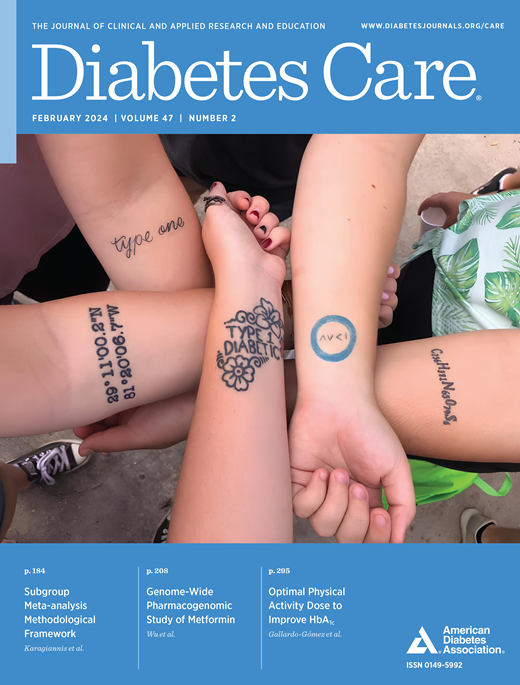Cutaneous Carbonyl Stress Is Associated With Nerve Dysfunction in Recent-Onset Type 2 Diabetes
IF 14.8
1区 医学
Q1 ENDOCRINOLOGY & METABOLISM
引用次数: 0
Abstract
OBJECTIVE Endogenous carbonyl stress leads to the formation of advanced glycation end products (AGEs). AGEs represent a potential target to prevent or treat diabetic sensorimotor polyneuropathy (DSPN). The current study aimed to characterize cutaneous carbonyl stress, oxidative stress, immune cells, and endothelial cell damage in early type 2 diabetes compared with normal glucose tolerance (NGT) using novel cutaneous biomarkers. RESEARCH DESIGN AND METHODS Included were 160 individuals recently (≤12 months) diagnosed with type 2 diabetes and 144 with NGT from the German Diabetes Study baseline cohort. Nerve function was assessed using electrophysiological, quantitative sensory, and clinical testing. Skin biopsies were obtained to analyze intraepidermal nerve fiber density, AGEs autofluorescence, argpyrimidine area, and endothelial cell area. In addition, skin autofluorescence was measured noninvasively using the AGE reader. A subgroup with type 2 diabetes (n = 80) was reassessed 5 years later. RESULTS After adjustment for sex, age, HbA1c, LDL cholesterol, and BMI, argpyrimidine area (17.5 ± 18.8 vs. 11.7 ± 12.7%) was higher in recent-onset type 2 diabetes than in NGT (P < 0.05). AGEs autofluorescence was inversely correlated with nerve conduction (e.g., peroneal motor nerve conduction velocity: r = −0.346) and positively with AGE reader measurements in type 2 diabetes (r = 0.358, all P < 0.05), but not in NGT. Higher baseline AGEs autofluorescence and lower endothelial cell area predicted the deterioration of clinical and neurophysiological measures after 5 years. CONCLUSIONS Cutaneous AGEs markers were associated with neurophysiological deficits in recent-onset type 2 diabetes and predicted their progression after 5 years, substantiating the role of carbonyl stress in the development of early DSPN.皮肤羰基应激与新发 2 型糖尿病患者的神经功能障碍有关
目的 内源性羰基应激导致高级糖化终产物(AGEs)的形成。AGEs 是预防或治疗糖尿病感觉运动性多发性神经病(DSPN)的潜在靶点。本研究旨在利用新型皮肤生物标记物,描述 2 型糖尿病早期与正常糖耐量(NGT)相比的皮肤羰基应激、氧化应激、免疫细胞和内皮细胞损伤的特征。研究设计与方法 纳入德国糖尿病研究基线队列中最近(≤12 个月)确诊为 2 型糖尿病的 160 人和 NGT 患者 144 人。采用电生理学、定量感觉和临床测试评估神经功能。采集的皮肤活检组织用于分析表皮内神经纤维密度、AGEs 自发荧光、嘧啶精氨酸面积和内皮细胞面积。此外,还使用 AGE 阅读器对皮肤自发荧光进行了无创测量。5 年后对患有 2 型糖尿病的亚组(n = 80)进行了重新评估。结果 在对性别、年龄、HbA1c、低密度脂蛋白胆固醇和体重指数进行调整后,新近发病的 2 型糖尿病患者的嘧啶酸面积(17.5 ± 18.8 vs. 11.7 ± 12.7%)高于 NGT 患者(P < 0.05)。在2型糖尿病患者中,AGEs自身荧光与神经传导成反比(如腓肠运动神经传导速度:r = -0.346),与AGE读数测量成正比(r = 0.358,均为P &P;lt;0.05),而在NGT患者中则不然。较高的基线 AGEs 自发荧光和较低的内皮细胞面积预示着 5 年后临床和神经电生理指标的恶化。结论 皮肤 AGEs 标记与新近发病的 2 型糖尿病患者的神经电生理缺陷有关,并可预测其 5 年后的恶化情况,这证实了羰基应激在早期 DSPN 发病中的作用。
本文章由计算机程序翻译,如有差异,请以英文原文为准。
求助全文
约1分钟内获得全文
求助全文
来源期刊

Diabetes Care
医学-内分泌学与代谢
CiteScore
27.80
自引率
4.90%
发文量
449
审稿时长
1 months
期刊介绍:
The journal's overarching mission can be captured by the simple word "Care," reflecting its commitment to enhancing patient well-being. Diabetes Care aims to support better patient care by addressing the comprehensive needs of healthcare professionals dedicated to managing diabetes.
Diabetes Care serves as a valuable resource for healthcare practitioners, aiming to advance knowledge, foster research, and improve diabetes management. The journal publishes original research across various categories, including Clinical Care, Education, Nutrition, Psychosocial Research, Epidemiology, Health Services Research, Emerging Treatments and Technologies, Pathophysiology, Complications, and Cardiovascular and Metabolic Risk. Additionally, Diabetes Care features ADA statements, consensus reports, review articles, letters to the editor, and health/medical news, appealing to a diverse audience of physicians, researchers, psychologists, educators, and other healthcare professionals.
 求助内容:
求助内容: 应助结果提醒方式:
应助结果提醒方式:


